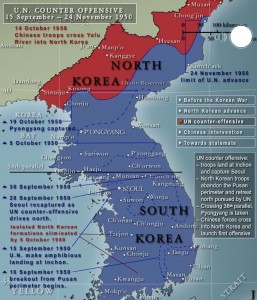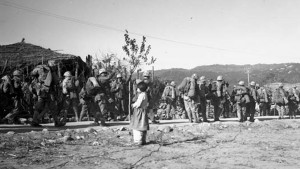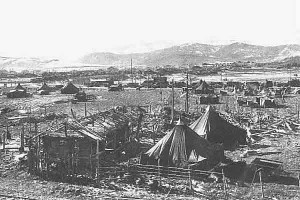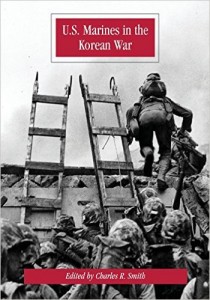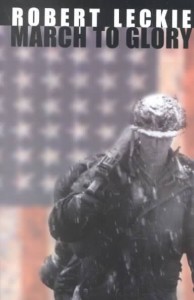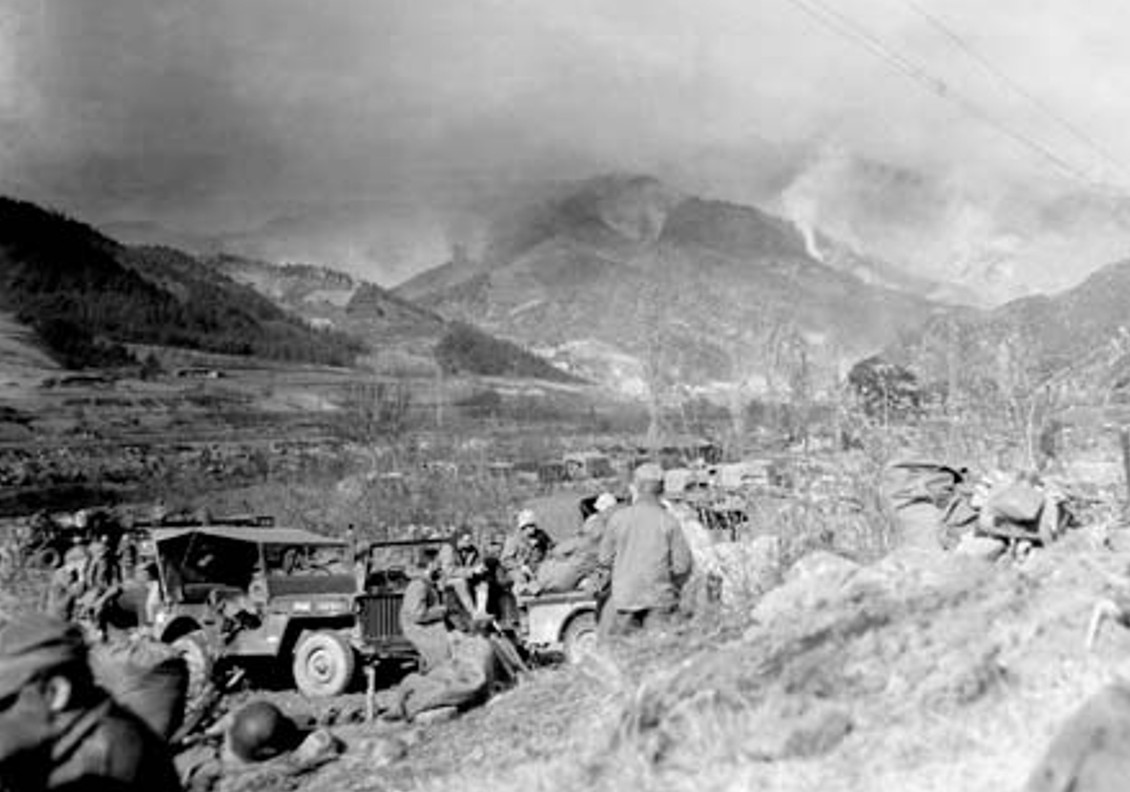 7th Marine Regiment heading for the Chosin Reservoir; some wearing, others carrying cold weather gear (DOD)
7th Marine Regiment heading for the Chosin Reservoir; some wearing, others carrying cold weather gear (DOD)
“A sense of security is very often the beginning of disaster…”
-Velleius Patercuslus- re Teutoburger Wald, 9 AD
“That’s impossible. There aren’t two Chinese Communist divisions in the whole of North Korea…” -Major General Edward M. Almond- Noon, 11/28/50 when told of eight Chinese Divisions attacking X Corps at Chosin
– – – – – – – – – – – – – – – – – – – – – – – – – – – – – – – – – – – – – – – – – – – – – – – – – – – – – – – – – — – – – – – – – – – – – – – – – – – – – – – – – – – – – – – – – – –
To see Part I, Part III, Part IV of BOTH SIDES OF THE CHOSIN series.
When Seoul was liberated the surviving NKPA units fled North with the Americans and South Koreans at their heels. The hunt was on and nobody on the UN side was thinking very clearly. “Quo Vadis…?” (Where to from here?)
A few naive types in the UN thought that forces would halt when they got to the previous border at the 38th Parallel. That would have been most unwise…The Parallel was simply a line on a map and was absolutely indefensible. At a minimum, an advance should be made to a reasonably defensible line north of the Parallel. (The war finished with the UN forces at such a line.)
A bit more ambitious, but fairly safe plan would have been advancing to the North Korean capital of Pyongyang. The idea would be to advance north of the capital just far enough to have a decent defensive line and run it east across the narrow waist of Korea to the Sea of Japan.
This would have a number of advantages. Any remaining North Korean entity would be a nonviable country without unending aid from China or Russia. “Ruling the rocks and crags…” It would also leave a buffer area between the new South Korea and China.
The Chinese were determined for a number of reasons not to have UN forces reach their border. They passed a warning on to the U.S. that if any forces other than South Korean approached their borders that they absolutely would commit troops.
Unfortunately the message was passed by way of an Indian diplomat known to be pro-Peking… The warning was dismissed as either an empty threat or an attempt to separate relatively weak South Korean forces from strong American support. MacArthur had told Truman that the Chinese would not commit major forces… and if they did, the Air Force would massacre them. (The Air Force never caught on until far too late…)
General MacArthur and the South Korean government demanded nothing less than a charge to the Yalu… the Chinese border. They were engaging in a giddy view of things rather than considering strategic realities.
The UN (at that point) would follow the lead of the American President. But both he and the Pentagon had “dropped the reins” and they were giving MacArthur his head. He had a history of at times being a “loose cannon” and on occasion needed “adult supervision…” They left him to run the show without at least carefully reviewing what might be involved. They abrogated their responsibility to the Republic.
Assuming that UN forces made it all the way to the Chinese (and Soviet) border without a shot being fired… what then? Declare victory and send the troops home? Simply leave South Korean troops (with the U.S. 3rd Infantry Division as was planned) to hold a border at least half as long as our frontier with (what would become) the Warsaw Pact?
Unlike Europe, road and rail connections to the Yalu were minimal. Most of the countryside was wild and mountainous. The NKPA might be across the border licking its wounds but would soon be able to strike the thin line of South Koreans and destroy them in detail. And China would always be in a position to take back at least North Korea any time that it chose, more if no large U.S. presence in Korea. The U.S. and its allies simply would not commit many divisions to years on the Chinese frontier.
The President and the Pentagon were not only going to allow this deployment to an indefensible and unsupportable line, but they did not warn MacArthur against advancing to the Yalu…not with a careful deployment capable of handling serious trouble… but like a sheriff heading a posse stampeding full tilt after bandits heading for the border.
INTO THE “NEVER NEVER LAND”
Ned Almond got his wish and X Corps was kept independent of Eighth Army.
Ignoring the fact that Inchon would have failed if the harbor was mined, MacArthur sent X Corps to try an amphibious landing at Wonson on the east coast of North Korea.
But this time, (using fishing junks) the North Koreans had mined Wonson, and had done a good job of it. The U.S. Navy did not have proper mine-sweeping support (adapted vessels manned by Japanese civilians had to take up the slack) and X Corps just sat offshore as many days passed.
By the time that a path through the mines was complete, South Korean troops had taken Wonson from the land. X Corps made an administrative landing. South Korean troops ashore had recently learned the “middle finger” gesture and smiled as they gave it to X Corps as they came ashore. Worse, Bob Hope and his entertainers were on site.
Ned Almond was fuming. Eighth Army was charging towards the Chinese border in the west and he was barely ashore. This war might end with his Corps in the “backwater…” He determined that he would do whatever it took to prevent this.
There had been some fuzzy thinking about maybe having X Corps simply occupy harbors along the coast of North Korea and only head for the border along the coast. But those orders were never issued… instead, X Corps would move inland… and then north to the Yalu.
X Corps was now a small army… at least on paper. On the far right of their advance to the Yalu would be two ROK divisions. The 7th Infantry Division was in the center and the 1st Marine Division was on the left flank. The 3rd Infantry Division was initially to be in reserve.
The Army’s 3rd Infantry Division began arriving in early November. The first regiment to land was the 65th Infantry on November 5th…made up largely of Puerto Ricans… Almond looked them over and defaulted to his lifelong prejudice. He announced to their regimental commander that he “did not have much confidence in these colored troops…” He was not impressed by the regimental commander’s comment that the troops were not colored, but were white.
After having told the regimental commander that his regiment lacked the confidence of their Corps commander… that same Corps commander informed the regimental C.O. that he planned on sending the regiment north, and then west… all the way across the face of Korea… across wild mountains… with no intelligence… to make contact with the Eighth Army’s right flank. A daunting task even in peacetime in clement weather.
The commander, Colonel William W. Harris, was appalled, as well he might be. This was far worse than the vague order at Balaclava that ultimately sent the Light Brigade to its doom. Fortunately for the 65th, other events intervened.
Some relatively minor NKPA activity caused parts of X Corps to be stretched out over an area 50 miles wide by 300 long. Other parts were heading north. Ultimately orders were given to close up the units, but some would not make it to the main action in time.
Everybody had their orders. The 1st Marine Division was to advance north some miles past the Chosin Reservoir. (The Koreans call it the “Changin” Reservoir, but the Americans were operating from Japanese maps with Japanese names…)
The road to the west of the Reservoir…once it left the flat coastal plain and went into the mountains became a relatively narrow dirt track that was designated the “Main Supply Route” (MSR). Large stretches had a hill face on one side and sometimes a drop-off on the other. Some parts looked like an “ambush valley” out of a Western movie. A dubious supply route for an entire division advancing against unknown resistance in increasingly near Arctic conditions.
The 1st Marine Division was a powerful fighting force…when deployed together. Their actual and planned deployment would stretch them impossibly thin. Of the three infantry regiments, the 1st had to close up from the South to even make it to Koto-ri…its final position. The bulk of Marine armor was with the 1st Marine Regiment at Koto-ri.
The 7th Marine Regiment was sent up to Yudam-ni…a crossroads village on the high plateau (along with the 11th, an artillery unit.) The 5th Marine Regiment moved partway up the east side of the Reservoir to cover the right flank of the division.
On a fairly wide patch on the road between Koto-ri and Yudam-ni was Hagaru-ri…which would become the reason for so much of what would happen to both the 1st Marine Division and Task Force Faith.
While not as high as the plateau, Hagaru-ri was at an elevation of 4000 feet. It was the “last chance” for an airstrip for quite a ways and General Smith was going to have one constructed.
The problem was that the engineers said the manuals called for a runway of 3,900 feet at 4000 feet altitude above sea level (if you needed to land twin engine C-47 transport aircraft.)
Within a reasonable amount of time they would only be able to construct a strip 3000 feet long. It would have to do. Marine combat engineers worked around the clock… with floodlights at night.
Hagaru-ri had most of the division support units. If the Chinese threw a massive effort at the position, it was likely that two regiments would be needed to hold its nearly four mile perimeter. General Smith had one battalion and whatever support troops that he could toss into the line.
When X Corps was spread out prior to the rush to the Yalu, General Almond was micromanaging many of the actions… down to the company level. When the Corps started to close up, he raised his sights.
Almond wanted the 5th Marine Regiment to move out from the east side of the Reservoir and join up with the 7th and 11th Regiments at Yudam-ni. He had plans for the two infantry regiments and their artillery. They would head west from the crossroads “cut enemy supply lines” and keep going until they “linked-up” with Eighth Army… and would “maintain contact” between the Eighth and X Corps. They would then head north to the Yalu.
The commander of the 1st Marine Division was stunned. Doubtless he had a picture in his mind of the 9th Legion marching into the mists of Britannia ca. 120 AD. Three of his four regiments at real risk of being wiped out…and he wouldn’t even be with them.
There was no point to the exercise. Eighth Army had more men and were not trying to “link up…” Too much wild country between the forces…and Eighth Army not only feared Chinese intervention…they had already had the 8th Cavalry Regiment of the 1st Cavalry division badly mangled by the Chinese… losing over 1000 men… and this was weeks ago.
On October 25th PRC forces had slammed into the ROK 1st Division along the 8th Army front. The Koreans were brave enough against the NKPA, but had an almost superstitious fear of the Chinese. By accident the Chinese 39th Corps collided with the unprepared U.S. 8th Cavalry Regiment in Unsan on November 1st…leaving one of its battalions with less than 200 survivors.
The ROK forces made contact with Chinese forces south of the Chosin Reservoir on October 25th and halted. The Marines engaged the PRC 124th Division on November 2nd. The Chinese retreated with heavy casualties. On November 6th PRC command ordered a retreat to the north to lure UN forces into the Chosin Reservoir area.
MacArthur was convinced that these were only “token” Chinese forces. Chinese prisoners gave ID on a large number of divisions. MacArthur didn’t want to believe it. His Chief of Intelligence, General Willoughby, “adjusted” reports to suit MacArthur’s wishful thinking.
He assured the General that only “parts” of the named divisions were present in Korea and were only there to act as a face saving gesture to screen the retreat of the NKPA. Reports to the contrary from lower echelons were “discouraged…” MacArthur ordered the Eighth Army to launch the “Home by Christmas Offensive…” Eighth Army obeyed… but at the higher levels dreaded advancing in pursuit order rather than tactical.
Ned Almond knew early on that there were Chinese troops in Korea. He was present when some of the first were brought in. He reported it to General Willoughby, who told others present, “If General Almond has actually seen Chinese soldiers…” Almond got angry and insisted. Willoughby briefed MacArthur who assured Almond that only small numbers were involved.
Whether Almond honestly believed that the Chinese had committed only relatively small numbers or not was irrelevant. He owed everything to MacArthur and would enthusiastically and unquestioningly carry out all of his orders. By November 21st when he ordered the Marine regiments to vanish into the snow… he was the only Corps commander in Korea who was still keen on continuing the charge to the Yalu.
Smith had been dragging his heels, trying to keep his division together, trying to avoid having the parts get too far out on a limb. Almond was impatient with him… but hesitated to relieve him for a number of reasons. The main one was that technically, the 1st Marine Division did not “belong” to X Corps, but was on “loan” from Pacific Naval Command in Hawaii.
Smith could only drag his heels so far. General Shepherd in Hawaii had gotten along ok with his fellow VMI graduate Almond and didn’t understand what the problem was. He told Smith to give Almond what he wanted.
Smith had done everything that he could, but he too was forced to obey. The 5th Marine Regiment was removed from flank protection duty east of the Reservoir and joined up in preparation for the fateful march to the west.
Almond decided that the East side of the Reservoir should be occupied… briefly, until that force too could be sent north. The 7th Infantry Division was tapped for a Regimental Combat Team (RCT). The force that would become Task Force Faith was assigned the task.
X Corps was stretched impossibly thin for anything more than pursuit in the face of no more than mild resistance… along a 400 mile front.
Suggested Reading

